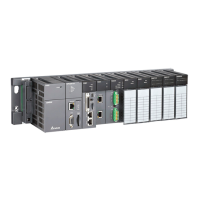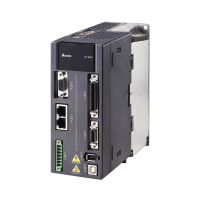AH500 Programming Manual
6-466
Example 2:
b15
b0
b7 b8
16#00
D21
16#20( )
16#31(1)
16#32(2) 16#33(3)
16#35(5)
16#34(4)
16#2E(.)
16#36(6)
16#38(8)
16#37(7)
10
3
12345678
D20
D22
D23
D24
D25
(D11,D10)
(D13,D12)
(D1,D0)
Number of characters
Number of decimal places
Additional remark:
1. If the number of characters contained in the string in S exceeds the range, the instruction is not
executed, SM0 is ON, and the error code in SR0 is 16#2003.
2. If the sign code in S is not 16#20, 16#2B, 16#30 and 16#2D, the instruction is not executed,
SM0 is ON, and the error code in SR0 is 16#2003.
3. If the decimal point in the string in S is not stored between the first character after the sign
character and the last character, the instruction is not executed, SM0 is ON, and the error code
in SR0 is 16#2003.
4. If the binary number converted from the string in S exceeds the range, the instruction is not
executed, SM0 is ON, and the error code in SR0 is 16#2003.
5. In the string in S, except for the sign code, the code representing the decimal point, and the
code which can be ignored, i.e. 16#20 or 16#30, the other codes have to be within the range
between 16#30 and 16#39. If the other codes are not within the range between 16#30 and
16#39, the instruction is not executed, SM0 is ON, and the error code in SR0 is 16#2003.
6. If the operand D
1
used during the execution of the 16-bit instruction is declared in ISPSoft, the
data type will be ARRAY [2] of WORD/INT.
7. If the operand D
1
used during the execution of the 32-bit instruction is declared in ISPSoft, the
data type will be ARRAY [2] of DWORD/DINT.

